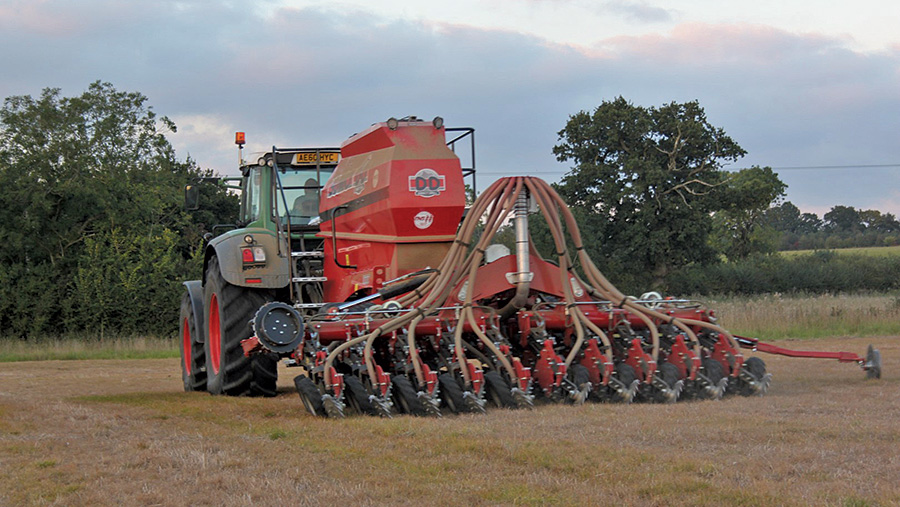Grower cuts establishment costs by £130/ha with new drills

A mixture of the good, the bad and the ugly is how one Suffolk-based AHDB monitor farmer describes his first autumn with two new drills and a different approach to crop establishment.
Having taken delivery of both a 4m Sumo DD and a 5m Sumo DTS at the beginning of September, Brian Barker put them into work immediately on the 667ha Lodge Farm, with the DD direct drilling late cover crops and the DTS planting winter wheat – as originally intended.
See also: Farmer reviews his £190,000 Cross Slot direct drill
The reason for replacing one cultivator drill with two drills was to cut establishment costs by moving less ground and including cover crops in the rotation.
He estimated they were moving 7.5m tonnes of soil over 580ha a year.

Teething problems
“We have had teething problems with both of them,” he admits.
“It’s been a steep learning curve, and things weren’t helped by the soil conditions. They were wet at depth, plasticine on top and had little natural tilth. With the benefit of hindsight, I should have waited a bit longer to drill.”
Some 273mm of rain in the seven-week harvest period was a contributing factor, he reveals.
“It was stressful. Harvest lasted from 21 July to 10 September, and of these 52 days, 26 were wet ones. That left us a legacy of wet soils and damp straw – both of which we’ve had to deal with.”
However, having completed the autumn drilling by mid-October, Mr Barker says he is 80% happy with the new system and gaining in confidence every day.
He tried out the drills into stubble, raked stubble, ploughed and cultivated land, to assess different approaches.
“We still have lots of questions, but we have managed to answer some of the more pressing ones.”
Chief among these is that direct drilling and min-tilling can be done in the wet, providing patience is applied, he notes. “However, coulter depth is critical in these conditions.”
Drill duo cost savings
- Saving in wheat establishment costs – difference of £131/ha equating to £39,162
- Less fuel use – 17,000 litres
- Tractor hours have fallen
With the previous establishment system at EJ Barker & Sons based on a Vaderstad drill, winter wheat establishment represented a crop average of £235/ha in fixed costs.
This autumn, with the new smaller drill system up and running, that figure has fallen to £104/ha, a difference of £131/ha.
“With wheat at £107/t, that’s worth 1.2t/ha, or £39,162 across the whole farm,” he points out.
Wearing metal
However, the savings don’t end there. “We are also spending less on wearing metal and have reduced our fuel use by 17,000 litres. Tractor hours have fallen too.”
However, his initial intention to reduce his horsepower requirement and replace his highest-horsepower Challenger has proved to be unrealistic.
“With the help of latest tyre technology, I had planned to go down from two tractors totalling 530hp and replace them with a single 280hp wheeled tractor. But it turns out that we still need a high-horsepower tractor for the DTS drill, and with ever tighter margins the investment strap is tight.”
Mr Barker admits that his main concerns with his new establishment system were pest problems and drilling into grass stubbles.
“We were expecting to encounter higher pest numbers and more crop damage, and we have certainly seen high slug numbers after rape. Aphids and pigeons are also a threat.
“Getting crops to come through the grass stubbles has to be tricky – the two-year leys that we have in the rotation form a thick mat of roots, which can make it difficult for the cereal crop to get going. They were slow to grow and we are seeing magnesium deficiency already.”
Other practical issues that arose included moving from 24m to 30m tramlines, while coping with wet soils and wet straw, he recalls.
“We subsoiled the old tramlines and then had some problems from moving soil in front of the drills.”
No response was seen to the use of Kieserite, broadcast in the spring last year, to supply magnesium and sulphur.
“We will use it down the drill spout in future to see if that helps.”
What’s more, the combine straw chopper must be working well, stresses Mr Barker.
“Residue management is important as we came up against difficulties with damp straw. Patience is required.”

Unanswered questions
Mr Barker would like more detailed answers to questions including whether to use a stubble rake or not, if fertiliser placement is beneficial and how much consolidation is required.
“We couldn’t put any fertiliser down the drill spouts into the seeding zone due to teething problems this year, but my instincts tell me that it will be needed.
“If we’re not mineralising nitrogen with cultivations, we’re likely to need other plant feed at drilling, especially with second cereals.
“Likewise, I felt that consolidation was lacking. Will we have to do more rolling with the new system?”
The greatest difference he has seen to date is with earthworm numbers.
“There are many more than previously. It’s been immediately apparent.”

